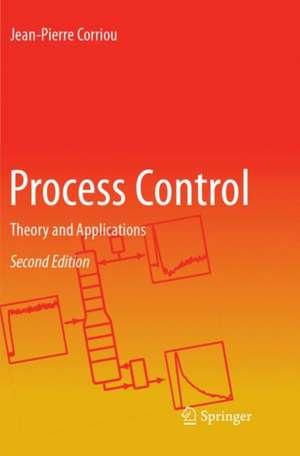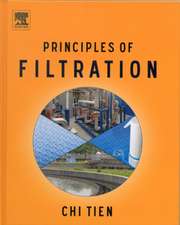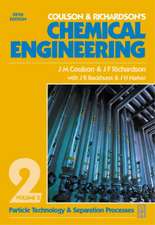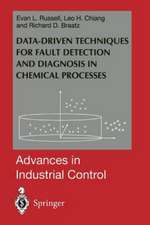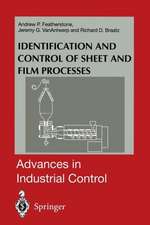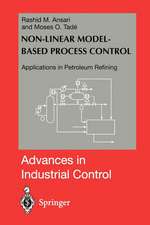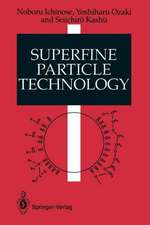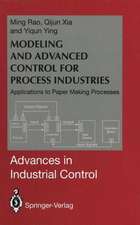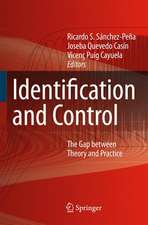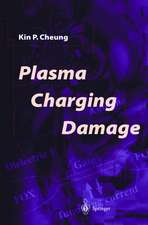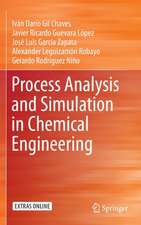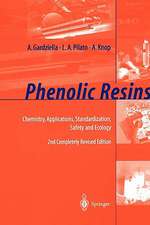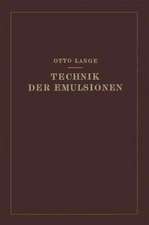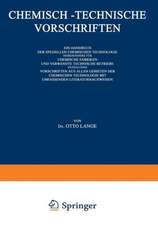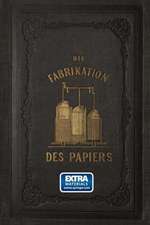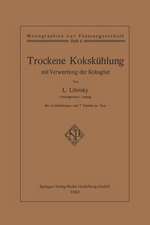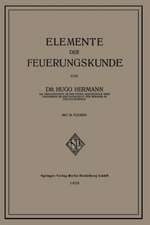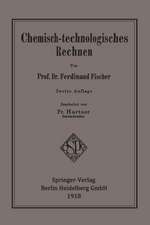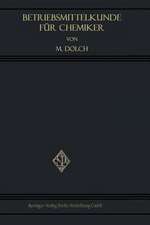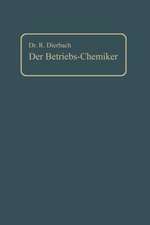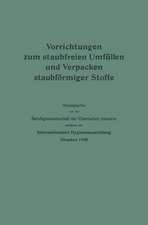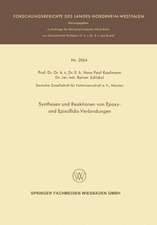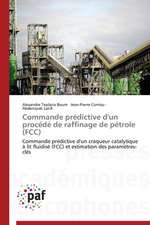Process Control: Theory and Applications
Autor Jean-Pierre Corriouen Limba Engleză Paperback – 9 sep 2018
A range of identification and control methods applicable to industrial processes are accompanied by practical examples, allowing readers to learn the subject both broadly and in depth. The expanded second edition of Process Control explores and introduces detailed topics, such as:
- new sections on tuning rules for feedback controllers;
- new sequences for parameter identification such as multi-level and multisinusoidal sequences;
- improved presentation of optimal control with dynamic optimization and model predictive control;
- deeper coverage of applications of nonlinear geometric control;
- expanded coverage of state observers, introducing the unscented and ensemble Kalman filters, the particle filter, the bootstrap filter, and providing more profound treatment of the Luenberger observer and high-gain observer; and
- more examples of process control.
| Toate formatele și edițiile | Preț | Express |
|---|---|---|
| Paperback (2) | 622.35 lei 38-44 zile | |
| Springer International Publishing – 9 sep 2018 | 622.35 lei 38-44 zile | |
| SPRINGER LONDON – 12 oct 2010 | 1107.46 lei 38-44 zile | |
| Hardback (2) | 834.00 lei 38-44 zile | |
| Springer International Publishing – sep 2017 | 834.00 lei 38-44 zile | |
| SPRINGER LONDON – 21 apr 2004 | 1243.78 lei 6-8 săpt. |
Preț: 622.35 lei
Preț vechi: 808.24 lei
-23% Nou
Puncte Express: 934
Preț estimativ în valută:
119.08€ • 124.34$ • 98.34£
119.08€ • 124.34$ • 98.34£
Carte tipărită la comandă
Livrare economică 11-17 aprilie
Preluare comenzi: 021 569.72.76
Specificații
ISBN-13: 9783319870144
ISBN-10: 3319870149
Pagini: 860
Ilustrații: XXIII, 860 p. 382 illus.
Dimensiuni: 155 x 235 mm
Ediția:Softcover reprint of the original 2nd ed. 2018
Editura: Springer International Publishing
Colecția Springer
Locul publicării:Cham, Switzerland
ISBN-10: 3319870149
Pagini: 860
Ilustrații: XXIII, 860 p. 382 illus.
Dimensiuni: 155 x 235 mm
Ediția:Softcover reprint of the original 2nd ed. 2018
Editura: Springer International Publishing
Colecția Springer
Locul publicării:Cham, Switzerland
Cuprins
1. Dynamic Modelling of Chemical Processes.- 2. Linear Feedback Control.- 3. Stability Analysis.- 4. Design of Feedback Controllers.- 5. Frequency Analysis.- 6. Improvement of Control Systems.- 7. State Representation, Controllability and Observability.- 8. Multivariable Control by Transfer Function Matrix.- 9. Discrete-Time Generalities and Basic Signal Processing.- 10. Identification Principles.- 11. Models and Methods for Parametric Identification.- 12. Parametric Estimation Algorithms.- 13. Digital Control.- 14. Optimal Control.- 15. Generalized Predictive Control.- 16. Model Predictive Control.- 17. Nonlinear Geometric Control.- 18. State Observers.- 19. Nonlinear Control of Reactors with State Estimation.- 20. Distillation Column Control.- 21. Examples and Benchmarks of Typical Processes.
Notă biografică
Jean-Pierre Corriou is an author of three books: Commande des Procédés, Lavoisier, Paris, 766 pages (three editions, 3rd 2012), Process Control, Theory and application, Springer, London, 2004, 752 pages, and Méthodes numériques et optimisation, Lavoisier, Paris, 2010, 442 pages. He is also author of 106 articles in national and international journals, as well as a reviewer for many journals, and an associate editor in the International Journal of Chemical Engineering and Mathematical Methods in Engineering.
Textul de pe ultima copertă
This textbook introduces the topics and theories of process control step-by-step in increasing complexity, making the learning of detailed techniques and algorithms easier. Whether you are a student starting in control, or an industrial engineer who, at present, only has cursory contact with control, the initial classical approach to continuous control by transfer functions will be of enormous benefit. The more advanced material on discrete control and state-space control, as well as nonlinear control and observers, requires minimal previous knowledge, assisting you to move more easily to the use of high-performance techniques.
A range of identification and control methods applicable to industrial processes are accompanied by practical examples, allowing readers to learn the subject both broadly and in depth. The expanded second edition of Process Control explores and introduces detailed topics, such as:
new sections on tuning rules for feedback controllers;
ne
w sequences for parameter identification such as multi-level and multisinusoidal sequences;
improved presentation of optimal control with dynamic optimization and model predictive control;
deeper coverage of applications of nonlinear geometric control;
expanded coverage of state observers, introducing the unscented and ensemble Kalman filters, the particle filter, the bootstrap filter, and providing more profound treatment of the Luenberger observer and high-gain observer; and
more examples of process control.
The book helps students to learn by using worked examples throughout the text, along with a downloadable solutions manual for the convenience of instructors. The broad coverage creates an important synthesis of the majority of aspects of process control, which gives a complete view of control theory and possible applications within the field, making the book accessible to engineers and academic researchers alike.
A range of identification and control methods applicable to industrial processes are accompanied by practical examples, allowing readers to learn the subject both broadly and in depth. The expanded second edition of Process Control explores and introduces detailed topics, such as:
new sections on tuning rules for feedback controllers;
ne
w sequences for parameter identification such as multi-level and multisinusoidal sequences;
improved presentation of optimal control with dynamic optimization and model predictive control;
deeper coverage of applications of nonlinear geometric control;
expanded coverage of state observers, introducing the unscented and ensemble Kalman filters, the particle filter, the bootstrap filter, and providing more profound treatment of the Luenberger observer and high-gain observer; and
more examples of process control.
The book helps students to learn by using worked examples throughout the text, along with a downloadable solutions manual for the convenience of instructors. The broad coverage creates an important synthesis of the majority of aspects of process control, which gives a complete view of control theory and possible applications within the field, making the book accessible to engineers and academic researchers alike.
Caracteristici
Presents the aspects of control that can help anyone to have a synthetic view of control theory and its process-industrial applications, in a single book Contains step-by-step processes for an easier understanding Illustrates control methods applicable to industrial processes with practical examples Includes supplementary material: sn.pub/extras
Descriere
Descriere de la o altă ediție sau format:
In Process Control, a wide range of identification and control methods applicable to processes are accompanied by typical comparable examples, encouraging you to make comparisons.
The initial classical approach to continuous control by transfer functions will be of enormous benefit, whether you are a student beginning in control or an engineer in industry who, up until now, has only had a superficial or empirical contact with control. The more advanced material on discrete control and state-space control, as well as nonlinear control and observers, requires minimal previous knowledge, allowing you to make better use of techniques with proven performance.
• Introduces concepts of progressively increasing difficulty, smoothing the path to learning the more advanced theories and control methods.
• For each topic, the theories, techniques and algorithms are presented in detail, with numberous references.
• The comparative consideration of different approaches to similar problems deepens your understanding.
• Examples that you can reproduce to master the different techniques.
Broad coverage creates an important synthesis of the spectrum of control theory and its process-industry-related applications. Different levels of reading are possible, opening this powerful source of information to engineers, academics, researchers and students alike.
In Process Control, a wide range of identification and control methods applicable to processes are accompanied by typical comparable examples, encouraging you to make comparisons.
The initial classical approach to continuous control by transfer functions will be of enormous benefit, whether you are a student beginning in control or an engineer in industry who, up until now, has only had a superficial or empirical contact with control. The more advanced material on discrete control and state-space control, as well as nonlinear control and observers, requires minimal previous knowledge, allowing you to make better use of techniques with proven performance.
• Introduces concepts of progressively increasing difficulty, smoothing the path to learning the more advanced theories and control methods.
• For each topic, the theories, techniques and algorithms are presented in detail, with numberous references.
• The comparative consideration of different approaches to similar problems deepens your understanding.
• Examples that you can reproduce to master the different techniques.
Broad coverage creates an important synthesis of the spectrum of control theory and its process-industry-related applications. Different levels of reading are possible, opening this powerful source of information to engineers, academics, researchers and students alike.
